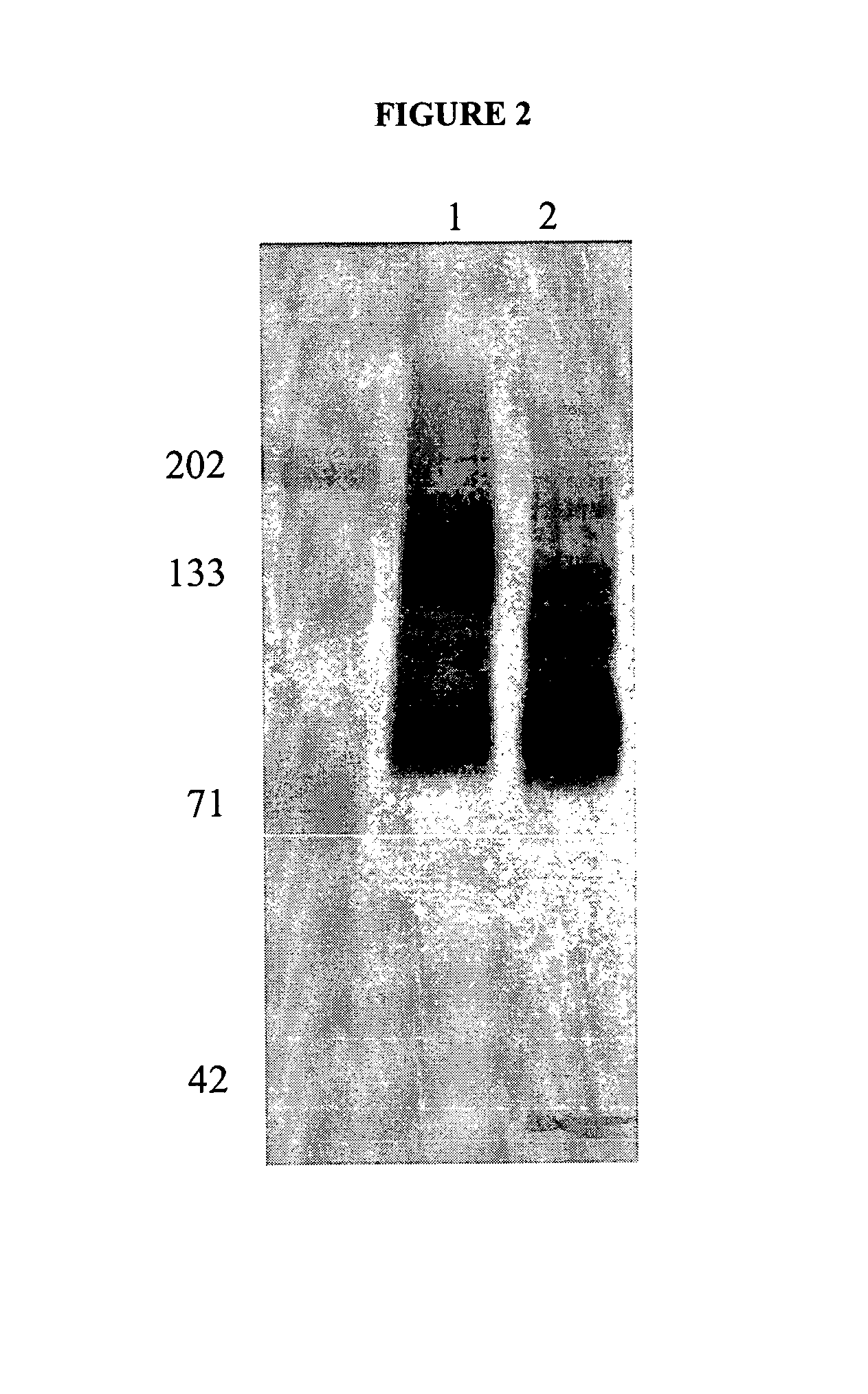Cytotoxicity mediation of cells evidencing surface expression of CD44
a cytotoxicity and surface expression technology, applied in the field of cancer diagnosis and treatment, can solve the problems of insufficient evidence, inconsistent findings, and increased likelihood of tumor invasiveness and induction of angiogenesis through the ecm
- Summary
- Abstract
- Description
- Claims
- Application Information
AI Technical Summary
Benefits of technology
Problems solved by technology
Method used
Image
Examples
example 1
Identification of Binding Proteins by Western Blotting
[0081]To identify the antigen(s) recognized by the antibody H460-16-2, cell membranes expressing this antigen were subjected to gel electrophoresis, and transferred to membranes. Western blotting was used to determine proteins detected by this antibody.
1. Membrane Preparation
[0082]Previous work demonstrated binding by FACS of H460-16-2 to the breast cancer cell lines MDA-MB-231 (MB-231) and MDA-MB-468 (MB-468). Accordingly, membrane preparations from these two cell lines were used for antigen identification. Total cell membranes were prepared from confluent cultures of MB-231 or MB-468 breast cancer cells. Media was removed from flasks, and the cells were washed 3 times with PBS. After the final wash, cells were dissociated with Dissociation Buffer (Gibco-BRL; Grand Island, N.Y.) for 5 min at 37° C. Cells were collected and centrifuged at 1200 rpm for 10 minutes at 4° C. After centrifugation, cell pellets were resuspended in 1 mL...
example 2
Determining Glycosylation of Antigens Bound by H460-16-2
[0089]In order to determine if the antigen(s) recognized by the antibody H460-16-2 were glycoproteins, MB-231 membranes were incubated with PNGase F, Endo-o-glycosidase, and sialidase A according to manufacturer's protocol (DeglycoPro deglycosylation kit; Prozyme, San Leandro, Calif.) for 24 hr at room temperature or at 37° C. Membranes were separated by 1-D polyacrylamide gel electrophoresis as described, and then Western blotting was carried out as described with H460-16-2. The results of the Western blot are shown in FIG. 5. In MB-468 membranes that were not treated with glycosidases, H460-16-2 recognized the expected 85-95 kD band (FIG. 5, Panel A, Lane 2). In membranes treated with glycosidases at 25° C., there is a distinct shift of this band to a lower molecular weight (Lane 4). In membranes treated with glycosidases at 37° C., the binding of 14460-16-2 is eliminated (Lane 3). In order to determine the completeness of de...
example 3
Identification of Antigens Bound by H460-16-2
[0091]1 mL of Protein G Dynabeads (DYNAL) was washed 3 times with 0.1 M sodium phosphate buffer, pH 6.0. 2500 μg of H460-16-2 was added to the washed beads in a total volume of 500 μl. The mixture was incubated with gentle mixing for 1 hr. Unbound antibody was removed and the H460-16-2-coated beads were washed 3 times in 2.5 mL volumes of 0.1 M sodium phosphate buffer, pH 7.4 containing 0.1 percent Tween-20. The H460-16-2-coated beads were washed 2 times in 5 mL of 0.2 M triethanolamine, pH 8.2 followed by the addition of 5 mL. H460-16-2 was chemically crosslinked to the beads by gentle mixing in the presence of 5 mL of 0.2 M triethanolamine, pH 8.2 containing 20 mM dimethyl pimelimidate for 30 min. The reaction was stopped by the addition of 5 mL of 50 mM Tris, pH 7.5. After 15 min incubation, the H460-16-2 crosslinked beads were washed 3 times in PBS containing 0.1 percent Tween-20. The H460-16-2-crosslinked beads ...
PUM
| Property | Measurement | Unit |
|---|---|---|
| temperature | aaaaa | aaaaa |
| total volume | aaaaa | aaaaa |
| pH | aaaaa | aaaaa |
Abstract
Description
Claims
Application Information
 Login to View More
Login to View More - R&D
- Intellectual Property
- Life Sciences
- Materials
- Tech Scout
- Unparalleled Data Quality
- Higher Quality Content
- 60% Fewer Hallucinations
Browse by: Latest US Patents, China's latest patents, Technical Efficacy Thesaurus, Application Domain, Technology Topic, Popular Technical Reports.
© 2025 PatSnap. All rights reserved.Legal|Privacy policy|Modern Slavery Act Transparency Statement|Sitemap|About US| Contact US: help@patsnap.com



